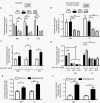Alpha 1-antichymotrypsin contributes to stem cell characteristics and enhances tumorigenicity of glioblastoma
- PMID: 33249487
- PMCID: PMC8041345
- DOI: 10.1093/neuonc/noaa264
Alpha 1-antichymotrypsin contributes to stem cell characteristics and enhances tumorigenicity of glioblastoma
Abstract
Background: Glioblastomas (GBMs) are the main primary brain tumors in adults with almost 100% recurrence rate. Patients with lateral ventricle proximal GBMs (LV-GBMs) exhibit worse survival compared to distal locations for unknown reasons. One hypothesis is the proximity of these tumors to the cerebrospinal fluid (CSF) and its chemical cues that can regulate cellular phenotype. We therefore investigated the role of CSF on GBM gene expression and the role of a CSF-induced gene, SERPINA3, in GBM malignancy in vitro and in vivo.
Methods: We utilized human CSF and GBM brain tumor-initiating cells (BTICs). We determined the impact of SERPINA3 expression in glioma patients using The Cancer Genome Atlas (TCGA) database. SERPINA3 expression changes were evaluated at mRNA and protein levels. The effects of knockdown (KD) and overexpression (OE) of SERPINA3 on cell migration, viability and cell proliferation were evaluated. Stem cell characteristics on KD cells were evaluated by differentiation and colony formation experiments. Tumor growth was studied by intracranial and flank injections.
Results: GBM-CSF increased BTIC migration accompanied by upregulation of the SERPINA3 gene. In patient samples and TCGA data, we observed SERPINA3 to correlate directly with brain tumor grade and indirectly with GBM patient survival. SERPINA3 KD induced a decrease in cell proliferation, migration, invasion, and stem cell characteristics, while SERPINA3 OE increased cell migration. In vivo, SERPINA3 KD BTICs showed increased survival in a murine model.
Conclusions: SERPINA3 plays a key role in GBM malignancy and its inhibition results in a better outcome using GBM preclinical models.
Keywords: SERPINA3; alpha 1-antichymotrypsin; brain tumor; cerebrospinal fluid; glioblastoma.
© The Author(s) 2020. Published by Oxford University Press on behalf of the Society for Neuro-Oncology. All rights reserved. For permissions, please e-mail: journals.permissions@oup.com.
Figures






Comment in
-
Fountain of chaos: cerebrospinal fluid enhancement of cancer stem cells in glioblastoma.Neuro Oncol. 2021 Apr 12;23(4):530-532. doi: 10.1093/neuonc/noab026. Neuro Oncol. 2021. PMID: 33749775 Free PMC article. No abstract available.
-
SERPINA3 in glioblastoma and Alzheimer's disease.Aging (Albany NY). 2021 Sep 29;13(18):21812-21813. doi: 10.18632/aging.203603. Epub 2021 Sep 29. Aging (Albany NY). 2021. PMID: 34587119 Free PMC article. No abstract available.
References
-
- Omuro A, DeAngelis LM. Glioblastoma and other malignant gliomas: a clinical review. J Am Med Assoc. 2013;310(17):1842–1850. - PubMed
-
- Stupp R, Mason WP, van den Bent MJ, et al. ; European Organisation for Research and Treatment of Cancer Brain Tumor and Radiotherapy Groups; National Cancer Institute of Canada Clinical Trials Group . Radiotherapy plus concomitant and adjuvant temozolomide for glioblastoma. N Engl J Med. 2005;352(10):987–996. - PubMed
-
- Lu VM, Goyal A, Graffeo CS, et al. . Survival benefit of maximal resection for glioblastoma reoperation in the temozolomide era: a meta-analysis. World Neurosurg. 2019;127:31–37. - PubMed
Publication types
MeSH terms
Substances
Grants and funding
LinkOut - more resources
Full Text Sources
Medical
Miscellaneous

